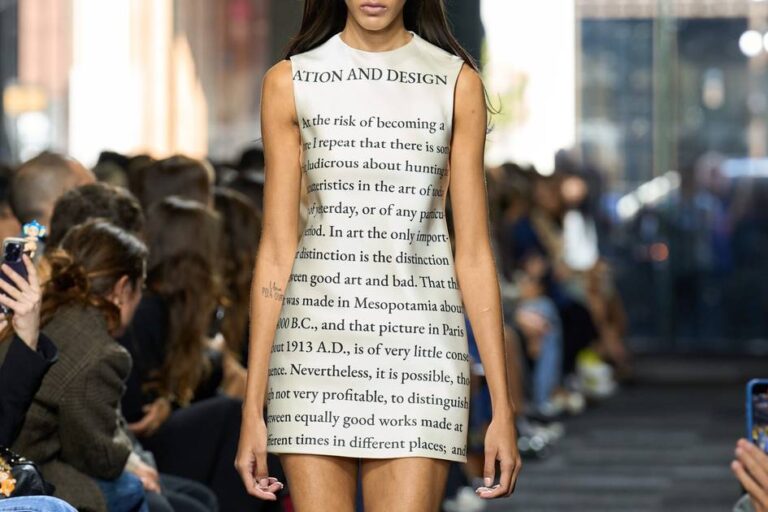Fashion reflects the desires and challenges of society – and when the times get darker, we are increasingly looking for light. In an era that is characterized by fake news, endless doom scrolls and an omnipresent negativity bias, an urgent restart is essential.
The Zeitgeist analysis for the coming spring/summer season, presented by the Deutsches Fashion Institut (DMI), started exactly here. Trend researcher and DMI director Carl Tillessen suggested a “Detox Society” during the online fashion day and therefore an urgent need for detoxification – social, digital and aesthetic.
Fashion seems to have heard the call from the trend researcher, because after years of visual overstimulation and an excess of social media-driven superficiality, she is experiencing a Renaissance of values, Intellect and Mindfulness for SS26. The latest collections have already shown that designers focus more on content and substance and present us a antidote for the toxic influences of the digital dynamics.
Intellectualism as a remedy
The fashion of the upcoming SS26 season raises inner values to the highest Maxime. The first steps in the right direction were already taken in the previous summer season. For example, the Italian label del Core focused on literary references and fashioned fashion for a ‘fictional scientist’ who would not leave the house without works by authors such as Hannah Arendt and Susan Sontag. A choice that makes it clear that Intellect and Education will be the accessories of the future.
Books become essential accessories, and Sontag finds resonance in various other collections. Jonathan Anderson, for example, was inspired by Sontag’s work “Against Interpretation” for his Loewe collection.
The designer went one step further and integrated literary quotes in the knitwear of his own label JW Anderson. The British label Erdem continued this idea by processing book covers as labels – further proof that the printed word becomes a central motive.
This tribute to literary inspiration bears witness to a movement that consciously opposes the superficiality of visual media, but also turns away from online media and moves towards the almost antique newspaper, which has become rare in an era of fast -shrinking print publications. It is therefore no surprise that the classic press, which is seen in this context as a conscious counterpoint for the often manipulative dynamics of digital platforms, is not only present in the first row of fashion shows, but also finds its place on the catwalks.
At Miu Miu, the seats of the guests were decorated with newspapers, and the location was reminiscent of a printing company in which the latest edition literally floated through the room. Stella McCartney also grabbed this motif. The British designer staged newspapers as accessories that wore the models in their hands or bags. However, the bottom line is that it does not seem to matter whether they are being used as a decorative design element in space or as an accessory in the hands of the models – the medium of the past becomes the fashion of the future.
Saint Laurent also underlines this trend with his latest campaign, which puts books and reading models in the spotlight. Reading, and the written word, is thereby re -celebrated, not only as aesthetic but also as an intellectual act – an alternative to the fast -moving consumption culture.
From gigantism to intimacy
The way of telling stories is not only formed by Roman heroes and star authors, but also by a slower style of staging. Where previously visual over -stimulation and the pursuit of maximum attention dominated, a trend of delay and conscious staging now applies. This change is primarily driven by a growing desire for authenticity and attention to detail – largely formed by a reconsideration of the previous mechanisms of social media.
“In recent years, visual over -stimulation on the internet and the associated unrest in the staging of fashion shows has often been elevated to the only contemporary attitude towards the world,” says Tillessen. But that is changing now, because although the big fashion shows still supplied a spectacle of overwhelming splendor – catwalks made of 1,000 original suitcases at Louis Vuitton or a gigantic bird cage at Chanel – it was mainly the small, charming details that were remembered.
The best examples of this were at Bottega Veneta and Loewe, where lovingly designed details such as crocheted flowers or handmade Tasengers became secret stars. It is these small, charming accents that linger and conquer the hearts of the viewer. The focus shifts from pompous staging to the “trivialities” that radiate depth and personality and are not only examples of craftsmanship, but also symbols of a paradigm shift. Away from giantism, towards an intimate, accessible aesthetics.
This shift is also reflected in the presentation itself. Where once the goal was to oversapt with visual effects, there is now peace and concentration. Alessandro Michele’s Transformation – from Gucci to his current work at Valentino – is a recent example. According to trend researcher Tillessen, Michele’s new collections invite pausers, notice details and discover the silent stories behind the designs.
Fashion, once the backdrop for the biggest spectacle, will increasingly become the stage for silent stories in the spring/summer of 2026. It is an expression of our time, because in a world that has become louder and faster, the silent, the soft and real meaning, says Tillessen, who interprets this development as a self -protection mechanism against the toxic side effects of social media.
This article previously appeared on FashionUnited.de. This article was translated by Susan Zijp using an AI tool.
FashionUnited uses AI Taaltools to speed up the translation of (news) articles and to test the translations to improve the end result. This saves our human journalists time that they can spend on research and writing their own articles. Articles translated with the help of AI are checked and edited by a human desk editor before they go online. If you have any questions or comments about this process, send an e-mail to info@fashionunited.com.


